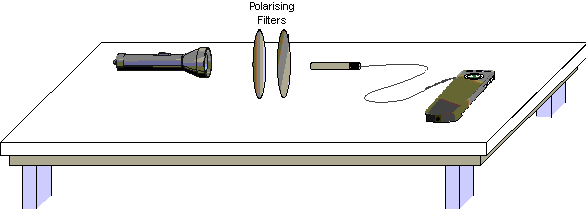|
Polarisation
of Light
1. Introduction
Perhaps
you have seen a display of polarised sunglasses in a store. You
can quickly test to see if the glasses are really polarised by looking
through the lenses of two glasses and rotating one pair by 90°.
If both pairs of glasses are polarised, the lenses will appear to
go black. Why is that?
To
explain the darkened lenses, we need to think of the light as an
electromagnetic wave. An electromagnetic wave has varying electric
and magnetic fields perpendicular to the direction the wave is travelling.
This experiment focuses only on the electric field variation, represented
by a vector. Light emitted from a typical source such as a flashlight
is randomly polarised, meaning that the electric vector points in
varying directions.
An
ideal polarising filter will remove all electric fields except those that
are parallel to the axis of the filter. The light remaining is then
said to be polarised. A second filter can be used to detect the
polarisation; in this case, the second filter is called an analyser.
The transmission through the second filter depends on the angle
between its axis and the axis of the first filter. In this experiment
you will study the relationship between the light intensity transmitted
through two polarising filters and the angle between the filter
axes.

2. Objective
|
|
Observe
the change in light intensity of light passing through crossed
polarising filters. |
|
|
Measure the transmission of light through two polarising filters
as a function of the angle between their axes and compare it
to Malus Law. |
3. Equipment
List
 |
Datalogger
interface |
 |
Datalogger
software |
 |
Light sensor |
 |
Light source |
 |
Polarising
filters (2) with marked axes |
 |
Protractor |
Procedure
| 1.
|
Place
the light source, polarising filters, and light sensor so light
passes through the filters and then into the sensor. You will
rotate only one filter to change the transmission; the other
filter, the light source, and the sensor, must not move. Turn
on the light source.
|
| 2.
|
Connect
the light sensor to the datalogger interface. If your sensor
has a range switch, set it to the 600 Lux range.
|
| 3. |
Open
the experiment worksheet using the datalogger software. Light
intensity is plotted versus analyser angle.
|
| 4. |
Rotate
the analyser until the Light Sensor reading is maximised. If
the reading is larger than 600 Lux, reduce the intensity of
the light source and rotate the analyser again for maximum sensor
reading. This is your zero angle. The axis marks on the two
filters should be parallel.
|
| 5. |
Set
the filters so their axes are at right angles. Very little light
should get through the pair of filters. Define the light level
as zero. The intensity reading should now be near zero.
|
| 6. |
Return
the analyser to the parallel position. Start the collection of data
in the datalogger software.
|
| 7. |
Rotate
the analyser by 15°, record the angle at 15°. Repeat this process
until you have rotated the analyser through one revolution,
or 360° before stopping the data collection.
|
| |
|
Analysis
| 1.
|
Place
one polarising filter on top of a second so you have to look
through both of them. Rotate the top filter until the axis marks
are at right angles to one another. What do you notice? |
| 2.
|
Rotate
a filter so the axes are now parallel. Look through the stack
and rotate the top filter about your viewing axis by 180°.
Make a qualitative graph of the transmitted light intensity
you observed as a function of the angle. |
| 3. |
Describe
your graph of light intensity versus angle, giving important
patterns and points. |
| 4. |
In the
1800s Malus proposed

to
predict the light transmission through two polarising filters,
where  is
the intensity when the angle is
the intensity when the angle  between the polariser axes is zero.
between the polariser axes is zero.
|
| 5. |
Compare the data to the model. Is your data consistent with
Malus' Law? |
|
|
|